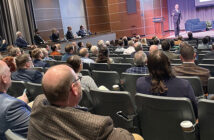by Dave Clark
There is a growing problem in our country. The economy is now recovering from the government-imposed mandates, which effectively shut down the national economy. However, employment has not matched that growth. Employers are having difficulties finding applicants. What happened to our workforce?
The economy had a modest steady growth rate after a slump in 2016. The rate of growth collapsed after the pandemic-related directives, which shuttered many operations, particularly small businesses. It crashed in mid-2020. Since the start of the 2021 recovery the rate increased to above six percent.
Unemployment initially followed this trajectory. In 2020, unemployment rate increased,then peaked in April at 14.7 percent. Unemployed workers rose to 23.1 million. Since then, the unemployment rate has steadily declined.
However, the growth in jobs has been sporadic despite an increasing demand for labor.
What has happened?
There are two disparate notions to explain the dichotomy between economic growth and employment. They differ significantly in their explanation of causes and respective solutions. However, both point to a potential negative impact on the national economy.
One posits a fundamental mismatch between job openings and the skills of the unemployed. The “New Economy” now emerging from the Pandemic Era is substantively different than before while the workforce skill base remains the same.
When the unemployment rate spiked during the spring of 2020, jobs that required a college degree declined more than others. The rapidly growing e-commerce sparked by pandemic-related government restrictions will likely continue. This will further increase demand for technology-based jobs, which were already in short supply.
This is consistent with a more concerning trend, “The Great Resignation.” Globally, workers are quitting their jobs in record numbers. This movement is driven by those with the least longevity in the labor market. A study by Adobe found that more than half of the Gen Z respondents said they would be seeking new employment in the next year. It is also a reflection of the breakdown of the social contract between employer and employee, particularly when businesses transition to multiple part-time workers rather than full-time employees with benefits. Such conditions exacerbate the impediments for those who might otherwise consider reentering the labor force.
This growing mismatch may be true in the some (primarily tech-related) sectors and explain part of the problem, but there is a hidden issue at the heart of the growth-employment gap.
In response to the very real pain caused by the business shutdowns, the government has dramatically increased spending. Already, there have been two tranches of stimulus expenditures totaling over $3 trillion in deficit spending.
Outlays were targeted at both businesses and their employees. Programs like the Payroll Protection Plan aimed at assisting companies retain employees. However, many were furloughed once the payments expired. This increased the employment gap because it discouraged businesses from transforming to meet the market.
Likewise, employees were supported through stimulus payments and supplemental unemployment funding. Unfortunately, this has created an “adverse incentive.” Often, the payments to stay home were larger than the amount an employee could make in their previous jobs. This is particularly true in the hospitality and retail sectors where wages are lower.
With the easing of government-imposed restrictions, business rehiring increased, yet many jobs go unfilled. Locally, “now hiring” signs have become ubiquitous. A significant reason for this appears to be related to the $300 weekly unemployment boost the Biden administration extended through the beginning of this month. Sensibly, Gov. Bill Lee has withdrawn Tennessee from that program.
There are clearly cases where some form of assistance is warranted; however, the Federal government’s “one kind fits all” policy, has been counterproductive. They created a deliberate program which disincentivizes workers from actually “working.”
As Fazoli’s CEO Carl Howard put it, “If I was a kid and … I’m making all this money to stay at home. I’m playing PlayStation till four o’clock in the morning. I’m not going back to work. Are you kidding me?” Some local restaurants have gone to pick-up only or have extended wait times for service simply because they cannot find enough workers to fill open positions. Yet there are able-bodied citizens available.
What will happen now? Will we allow the additional benefits to sunset this month giving people the motivation to re-enter the workplace? Or will the government simply say, “Look at all these unemployed people; we need to continue to support them?” Unfortunately, the latter is the more likely outcome. This will continue to undermine the health of our economy and further the trend towards dependency on government largess.
Where have all the employees gone? Well, they appear to be at home. The question is“How do we get them back to work?”
Dave Clark is a seasoned entrepreneur and businessman in Kingsport and was recently appointed Vice President of Entrepreneurial Ecosystem Development with the ETSU Research Corporation.





